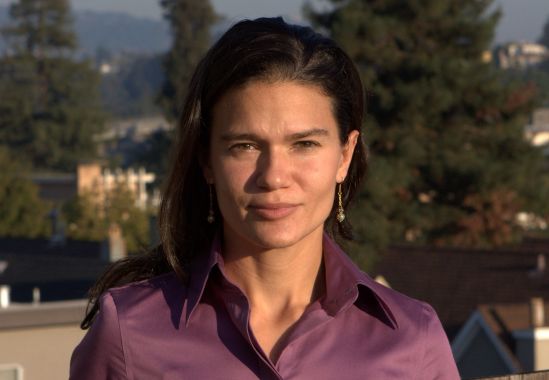Jacki Lopez is Florida director and a staff attorney for the Center for Biological Diversity. The international nonprofit organization started 25 years ago in New Mexico with a landmark campaign to save the spotted owl, the flagship species of conservationists.
 A Florida native, Lopez joined the Center in 2002 and works out of St. Petersburg. She coordinates campaigns in the Southeast and Caribbean, applying law, science and public advocacy to protect imperiled species and ecosystems. Lopez kindly answered Five Questions for The Daily Fray:
A Florida native, Lopez joined the Center in 2002 and works out of St. Petersburg. She coordinates campaigns in the Southeast and Caribbean, applying law, science and public advocacy to protect imperiled species and ecosystems. Lopez kindly answered Five Questions for The Daily Fray:
• What is your goal in Florida with the Center?
The mission of the Center for Biological Diversity is to protect and conserve imperiled species and the places they call home, and there are few places in America under greater threat than Florida. Florida is unlike any other place with its diversity of habitats -- swamps, sandy beaches, and freshwater springs -- and the species they support -- wood storks, sea turtles, and manatees. Florida’s history is unique too; with the draining of the Everglades in the early part of the 20th century and the rampant urban sprawl of the 1960s, it is no wonder that more than 50 plants and animals have been pushed to the brink of extinction. Today, Florida’s last remaining wild places are under extreme pressure from continuing urban development and rising seas. We work to limit the threats to these species in the hope that they will recover to the point where federal and state protections are no longer needed.
• You've gotten around during your educational stops -- Florida, Colorado, Arizona: What experiences drove you to join the CBD?
I grew up in Florida and spent most of my time outdoors fishing in the Bay and stalking lizards in my neighborhood. As I grew older I became more aware of and concerned with how the built environment affects how people behave and how it impacts the natural environment. When I moved out west I became familiar with the Center for Biological Diversity, where I started interning in the membership department. From there I was promoted to help with grant writing and then to managing the organization’s grants. During that time I earned a M.S. in urban planning, which helped me better understand how land-use decisions affect the environment and inspired me to become an environmental attorney. I never thought I’d move back to Florida, but as I grew more aware of how precious Florida’s natural resources (wild places and critters) are and how urgent the threats were against them, it became clear that the Center needed to deepen its presence in the region by opening a Florida office, which we did three years ago.
• As Florida director and a staff lawyer for the CBD, what do you consider your three greatest success stories?

We are still fairly new in the region, so I suspect our greatest victories are yet to come; however, some huge successes came over this last year with the federal designation of critical habitat for loggerhead sea turtles. The protection spans hundreds of miles, and most of them are on Florida’s beaches. We were also instrumental in stopping a proposed dredge in the Gulf of Mexico which would have been the largest dredge in the Gulf in 50 years. And earlier this year we hosted the first ever Florida Panther Symposium aimed at reintroducing panthers outside of their currently occupied south Florida range, an endeavor that we hope is now being seriously considered.
• What is the least understood environmental issue and/or threat in Florida, and what is CBD doing to change that? OK, that was an extra question.
The two most intractable threats have to do with water. Inland, our freshwater ecosystems are suffering from overwithdrawals and nonpoint source pollution. Meanwhile, our coasts are threatened by sea level rise caused by anthropogenic climate change. I say they are intractable because they are scientifically complex and politically charged, but that doesn’t mean they can’t be overcome. We are working to get freshwater species impacted by water quality and quantity issues listed and protected, through litigation and advocacy. We are also working to make local and federal governments accountable for how they (fail to) address the causes and effects of climate change.
• Finally, in a perfect world, what is your vision for Florida?
Every Floridian would appreciate what we have and would work together to preserve it. Local governments would get serious about climate change and start implementing land-use decisions protective of our natural coastlines. We’d invest in public lands and secure wildlife corridors that would facilitate natural movement of Florida black bears, Florida panthers, and other irreplaceable Florida species. Florida would be a positive example of good environmental stewardship for the rest of America.
 5=Q&A is a feature that appears periodically in The Daily Fray, spotlighting people, initiatives, places and things. For suggestions and comments, write: Editor@TheDailyFray.com.
5=Q&A is a feature that appears periodically in The Daily Fray, spotlighting people, initiatives, places and things. For suggestions and comments, write: Editor@TheDailyFray.com.
Outside
Bitcoin mining emissions in China will hit 130 million tonnes by 2024 https://t.co/w6He7so8N2 pic.twitter.com/qYUDtBdeRK
— New Scientist (@newscientist) April 9, 2021
The Gunk Report
For the Blue-Green Algal Bloom Weekly Update from the Florida Department of Environmental Protection, tap here. For DEP's Algal Bloom Sampling Map, tap here.
What, me worry?
» "PLAYING WITH SHARKS," which recently premiered at the Sundance Film Festival, documents diving legend Valerie Taylor.